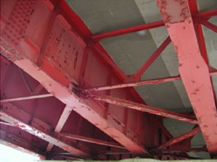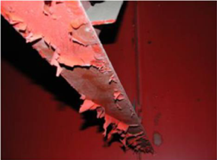We sat down with A&I Coatings Sales Director Ben Gillies to find out what is in fluoropolymer coatings? What are the performance advantages and what is the most cost effective way to manage vandalism of the coating?
“So we started first manufacturing coatings in 1981 and then in the late 1990s we were looking for the most durable coating possible and that led us to a company called Asahi Glass Company in Japan, owned by the Mitsubishi Group,” Ben Gillies said.
“So AGC are the inventors of fluoropolymer resin and they’ve been using them since the 1960’s; and what we do, we take the resin from AGC, we turn it into paint, which involves the addition of about 15 to 20 different ingredients including things like UV stabilizers, dispersing agents, various pigments etc, and then we supply that paint to Wagners who apply it to their FRP substrates.”
What is a fluoropolymer coating?

“Fluoropolymer coatings are still not well understood, although they are fast growing in popularity; so fluoropolymer coatings are also referred to as FEVE, which stands for Fluoro Ethylene Vinyl Ether (FEVE) resins. So when we’re talking about FEVE or Fluoropolymer, we’re talking about the same thing,” Mr Gillies said.
“Now in terms of the chemical structure it’s a similar structure to a polyurethane; however, it does have the addition of the fluorine molecule.”
“The key to the durability of fluoropolymers lies in the fact that the maximum UV energy is less than the main chain bond energy between the fluoroethylene and vinyl ether that combine to form fluoropolymers.
“So in a fluoropolymer molecule, the main chain bond energy between the fluoroethylene and the vinyl ether is 414 to 424 kilojoules,” Ben Gillies said.
“Now the maximum UV energy that hits us here on the earth surface is 411 kilojoules. So in essence, the maximum UV energy can’t break down the bond in the fluoropolymer molecule, and that’s simply why it lasts so long.
“So if you compare that to some of the other paint technologies that have been on the market for a long time, one of them would be polyurethane, its bond energy is 379 kilojoules. So you can see it’s below the maximum UV energy and that’s in essence why it breaks down quicker than fluoropolymer,” Mr Gillies said.
“And we all should understand that the maximum UV energy may only hit at certain times during the day or certain seasons. Nevertheless, it does hit and it does have an effect. So what the fluoropolymers offer is exceptional UV resistance; in fact, they’re still unparalleled in the market, the closest would be a polyurethane or a polysiloxane that still have roughly 1/3 of the life of the fluoropolymer.
“Fluoropolymers have superior chemical resistance, which also provides an added benefit of being graffiti resistant; and they have excellent thermal resistance as well as minimal film erosion.
Japan and fluoropolymers
Japan has a lot of great case studies for fluoropolymer because they were the inventor of the technology.
“In fact, Japan has proven the benefits of reduced maintenance to such an extent that the Japanese government has mandated that all bridges both new builds and those coming up for major maintenance, must be painted in a fluoropolymer coating,” Ben Gillies said.
“They’ve got about 37 years of solid usage history, and they’re already seeing the monetary benefits of going with a fluoropolymer.
“With the Daiichi Mukoyama Bridge in Japan, the arch section, when it was built, was painted in fluoropolymer and that was because the arch is hard to get to, it’s expensive to maintain and therefore they wanted to use the longest lasting coating system for those areas of the bridge,” Mr Gillies said.
“But on the approach sections they thought well, we can afford to save a little bit of money here, that’s easy to get to, easier to maintain, so they used an alkyd on the approach sections and after 16 years in 2003, you could see that the alkyd was ready for a major maintenance regime; it had completely broken down, whereas the arch section was still in good condition.
“So, they repainted the approach sections in a polyurethane thinking, well, we’ll still save a little bit of money, we won’t use a fluoropolymer and unfortunately the approach sections after another 12 years were still in worse shape than the original arch sections painted in fluoropolymer 30 years earlier.”
Penny wise and million dollars stupid; it’s better to look at what is down the track; because long-term it’s better for the government budget, it’s better for the taxpayer – Ben Gillies
How to spot film erosion and what does it mean?
“So over time with film erosion, as a coating is subjected to harsh weather patterns, it starts to lose its film depth and that manifests itself in a chalky appearance, loss of gloss, it looks old, it looks tired,” Ben Gillies said.
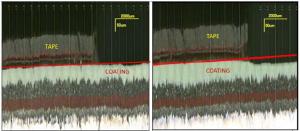
“The picture on the left is a cross section of a fluoropolymer coated sample; so you’ve got a primer and intermediate coating, a top coat and at the top there a section called ‘tape’ and what that is basically is a cover for half a panel, so that when you remove the panels from the test structure, you can take off the tape and you can see with and without exposure the difference,” Ben Gillies said.
“So these particular panels were placed on an off shore structure off the coast of Japan and what we have on the left side here is fluoropolymer and on the right side is polyurethane. After 15 years, you can see the polyurethane lost 22 to 28 microns of film thickness; meanwhile the fluoropolymer lost on average 1 micron; so the fluoropolymer essentially is still doing its job of protecting the underlying coats, which in turn protects the substrate.
“So when you actually look at this on a structure, what you’ll see is a tired looking coating; it’ll be chalky, potentially starting to crows feet and what it really does is it starts to create a pathway or create a weak spot for corrosion initiators to start to get to the substrate,” Mr Gillies said.
Development and testing of coatings
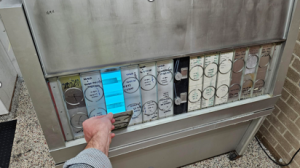
A&I Coating have a laboratory in the Southern Highlands of New South Wales with four full time chemists, and are regularly developing new coatings to provide different benefits.
“When we design a new coating system, and when we do that we obviously can’t afford to wait 60 years before we release that coating system, so we run accelerated testing,” Ben Gillies said.
“One of the machines we use to run accelerated testing is called a QUV machine and what it does is it pounds the samples with intense UV and then a cycle of humidity and condensation and it just greatly speeds up the degradation process.
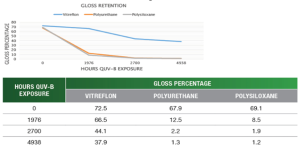
“So what we can see here is hours of exposure in the QUV machine and after nearly 5000 hours of exposure, which is equivalent to roughly 25 years’ real life, the fluoropolymer (marked as Vitreflon) has gone from 72 gloss units down to 37 gloss units; whereas the polyurethane has gone from 67 to 1, and the polysiloxane from 69 to 1. So right now the polyurethane and polysiloxane coated structures would be looking very tired and would be ready for a repaint,” Mr Gillies said.

On the other hand, the fluoropolymer is still fairly glossy, it has changed a little bit in colour to a minor extent, but it is still glossy, which means the coating is intact and still protecting the substrate; whereas when it starts to get chalky, that’s when you start to get film erosion.”
Is fluoropolymer graffiti resistant? And what’s the best way to treat graffiti?
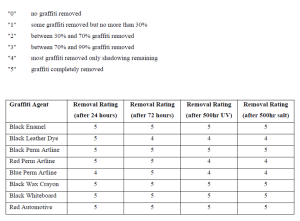
“Now an added benefit as we mentioned earlier of fluoropolymer coatings is their graffiti resistance and when we test for graffiti, we test a range of different types of graffiti and we test the removal rating with five being complete removal and zero being impossible to remove,” Ben Gillies said.
“We also leave the graffiti there for certain amounts of time including 24 hours, 72 hours, 500 hours in the QUV machine and 500 hours in our salt spray cabinet.
“Some of the graffiti can become a little bit harder to remove the longer that it is on there, because the longer you leave graffiti on a substrate the harder it is to get off; but you can see by the results that all the graffiti tested was removed relatively easily and marked above four being almost complete removal,” Mr Gillies said.
“Bunnings have got a product called Muck Off, which is a very effective graffiti remover and very readily available. However, any graffiti remover at a local paint store is most likely suitable.
“The way it’s removed is you spray the graffiti remover onto the graffiti, let it sit there for a couple of minutes, which starts to dissolve the graffiti and you simply take a rag and water and wipe it off. Some graffiti artists are fairly innovative and sometimes you might need two or three goes to completely remove the shadowing.”
What about more substantial graffiti or vandalism?
“We’ve all seen where vandals will scratch painted surfaces with keys or other sharp objects, which then needs to be repaired because if it exposes the substrate, that creates a weak point which overtime will get a lot worse if it’s not attended to,” Ben Gillies said.
“So for a simple repaint you would degrease the affected member, you can use a solvent based or water based degreaser we just need to make sure we remove any dust, dirt, exhaust grime basically anything that’s going to interfere with the adhesion of the coating.
“We then need to abrade the existing coating with a medium Scotch Brite; so basically, remove the gloss and create a uniform scratch pattern on the surface; then apply two coats of the fluoropolymer,” Mr Gillies said.
“Now when you do perform a repair on site, it’s often best to go from one end of the member to the other end of the member as it just makes the repair less obvious.
“Where the vandalism is more substantial it may actually be cheaper and more cost effective, or more practical to simply unbolt the member and install the new member which again is one of the great advantages of Wagners CFT; there’s no welding, there’s no site cutting, it’s simply unbolt and bolt in.”
How does fluoropolymer stack up to environmental scrutiny?
“Now, fluoropolymer coatings have a far reduced environmental footprint because they need such a lower number of repaints over their lifetime, and this is THE major benefit of fluoropolymer coatings; instead of repainting every 20 years, you’re repainting every 60 to 120 years,” Ben Gillies said.
“There’s been a lot of press around polyfluoroalkyl substances or PFAS; they’re also known as forever chemicals because in essence they don’t break down. I just wanted to make the point that fluoropolymer coatings have been exempt from that regulation, because they are not a forever chemical; so fluoropolymer coatings do break down in a similar fashion to polyurethane coatings, they just take a lot longer to do so.”
What about Total Cost of Ownership and reduced ongoing maintenance or reduced replacement cycles?
“So every time we’ve got to do a repaint you’ve got to do a list of things including a feasibility and project evaluation, project consultation, site and structure surveys, financials, legals and risk analysis, there’s environmental and ecological considerations.
“You’ve got to go to tender, there’s the contractors’ preliminaries, enabling works, contract administration, traffic management, surface preparation, waste disposal, the actual application of paint itself and the cost of the paint and then there’s the actual access to the site; is it difficult or easy to get to?
“We’ve got to go through all these steps and every one of them has a monetary cost as well as an environmental cost and sometimes, as you can imagine, structures that are hard to get to or need a lot of site mobilization become very expensive very quickly,” Ben Gillies said.
“So the fact that you only have to repaint a fluoropolymer structure every 60 to 120 years instead of every 20 years has a massive impact on both the environment and your budget, because every one of these activities has some sort of environmental impact; travel to and from site, whether it’s waste disposal, every time you paint the release volatile organic compounds or VOC’s nto the atmosphere; it all has an impact.”
Can you give us some examples of structures and coatings that haven’t performed well both here in Australia and overseas?
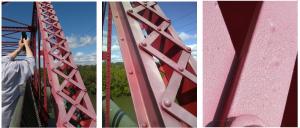
“This Australian bridge is a government asset and was painted in 2010 in polysiloxane. These photos were taken in 2017, which is just seven years of exposure,” Ben Gillies said.
“You can see on some of the shielded sections it still retains some kind of red colour; it was a really bright red to start with, but on the faces exposed to the UV and you can see it’s in total disrepair.
“There’s crow’s feet cracking, a total loss of gloss, chalking and what that does is create a pathway for corrosion initiators; and if you don’t do something about it they can get really bad really quickly, making the maintenance so much more expensive,” Mr Gillies said.

“Meanwhile, this very significant New South Wales bridge is 800 tons of steel, it is very visual, very aesthetic and was painted in a bright orange metallic finish in 2018 from a polysiloxane paint.
“Now you can see the far right photo anywhere it’s been hit by direct UV, it’s started to go white and chalky; and where it’s been shielded, you can see that it’s still the original colour and that’s only after five years so 2023,” Ben Gillies said..
“I would hate to put a price on what it’d be worth to repaint this bridge, but I’d put my money on it being repainted in the next decade, if not sooner. So I guess this just lends weight to the fact that bridges are often repainted because of visual appearance and the fluoropolymer coating creates a significant saving.”
What about some examples of structed coated with fluoropolymer?

“This was one of the first projects A&I coatings supplied for in Australia; it was started in the year 2002 and is now 22 years old, and you can see the vibrancy of that colour,” Ben Gillies said.
“It still looks the same today as the day that cladding was installed and all these colours are the worst possible colours for fading, so I don’t think we’ll be seeing a repaint on this building for another 40 years at least and even then, the coating will still be intact it may just have started to fade slightly.

“2013 Cairns Convention Centre, this was a full external repaint using fluoropolymer coating, so there’s a lot of asset owners out there that are proving the benefits of fluoropolymer coatings and we’ve now supplied enough coating to cover more than 3,000,000 square meters in Australia and there’s additional projects overseas.”

“Anzac Boardwalk in Newcastle, is a Wagners CFT project and if you look at the environment there, it’s a pretty corrosive environment; there’s breaking surf and it would probably be regarded as a C4, potentially a C5 environment.
“And what we’ve got here is a non ferrous structure, so there’s actually no elements on that structure that will corrode, although there is stainless steel, but we know that doesn’t corrode anywhere near as fast.
“Now the interesting point to make here, is on that painted Wagners CFT structure there’s about 60 microns of fluoropolymer coating, so it’s quite a thin film, Ben Gillies said.
“If that structure there was built out of mild steel, we would need to abrasive blast the mild steel to a Class 2 1/2 blast, and then apply a three coat system consisting of zinc for each epoxy, micaceous iron oxide epoxy and then a fluoropolymer topcoat, totalling around 350 microns.
“So we’d use roughly five times the amount of paint and in addition to that, we’d be painting three times as often, as a minimum, if it was mild steel painted in a polyurethane; so I guess this really highlights the durability of Wagners products in that environment,” Mr Gillies said.
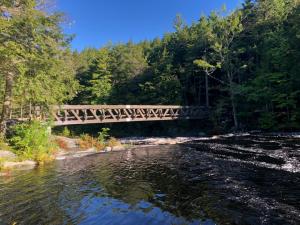
“The Mersey River Bridge is in the Kejimikujik National Park, Nova Scotia, Canada is a totally nonferrous structure coated in fluoropolymer over a waterway, so quite a corrosive environment, and the asset owner there is going to prove the benefits of that for decades and decades.
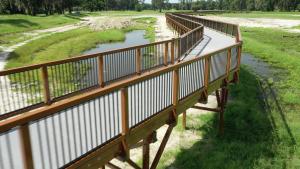
“This time in Florida; the Ocala Boardwalk goes over a wetland, so again a very corrosive environment; there’s no steel, so it won’t corrode, there’s no timber, so it won’t rot.
“It’s protected by a fluoropolymer coating so in addition, it won’t fade.”

“To look back at another Australian project which is quite significant, Sydney Metro, there’s about 110,000 square metres of steel that was painted on this project,” Ben Gillies said.
“A government consultant did a deep dive to look at what coatings we’re going to offer the best long-term value for money and they settled on fluoropolymer.”
Direct Questions and Answers
Question – What are the downsides of FEVE coatings apart from the fact they’re more expensive than other coatings?
“To be honest, there’s really no other downside. We also manufacture these other coatings; so we manufacture polyurethane coatings, we also make polysiloxane coatings; they all have their place, but whenever anybody wants an ultra-durable coating system on a structure that’s hard to maintain or want really vibrant colors or for any other reason they need ultra long durability, we go to fluoropolymer every time. So, in terms of application they’re exactly the same to apply. In fact, if we give our fluoropolymer to an applicator, they really can’t tell the difference between applying the polyurethane or a fluoropolymer. So, there’s no added cost in terms of application, there’s no added health risks associated with it. So, in essence, it is more expensive, but there’s no other downside.”
Question – You mentioned repairing damaged coating. Any special requirements for treatment around cuts and bolt holes?
“Yes. So, we do need to pay particular attention to those areas. However, with the Wagners substrate, it doesn’t actually require a primer, so our fluoropolymer coating is applied directly. So adhesion isn’t an issue if the substrate is exposed. You can just paint directly over the scratch or the damage. The only time you might need to perform any other additional repairs is if the scratches showing through, like if it’s a really deep scratch, you might have to fill that with a filler and epoxy filler first, and then you would sand back the epoxy filler and then apply fluropolymer as per usual. Apart from that, there’s no other treatment.”
Question – Are these coatings also applied to Wagners FRP poles; the ones used in power distribution?
“Correct they are. For our power poles in particular, I know that the same products that we use across their entire structural range, there are a few different grades of fluoropolymer that we do use and we sort of tailor them depending on which structure we’re doing, you know substructure top structure in the poles, but you know generally the fluoropolymer chemistry is the same across the entire range.” – David Bolin, Wagners CFT Lead R&D Engineer
Question – What would cost increase percentage ballpark figure look like for FEVE’s versus PU’s?
“So as a general rule a fluoropolymer coating will be roughly 2.5 times more expensive than a polyurethane coating. I find it really helpful to break it down to extra cost per square metre because it’s not as big as what you first think. So, for example, on a steel substrate, a three-coat system might typically cost $95 per square metre supplied and applied. A fluoropolymer system might cost $100 to $105 supplied and applied, so it’s actually not a great increase if you take into account the application costs as well. And then if you look at something like a bridge for bridge maintenance, it ends up such a small percentage that it is totally worthwhile for the amount of money that you save ongoing through reduced maintenance.”
Question – If a structure’s coating is repaired due to vandalism. Does it void the warranty on the coating?
“It doesn’t void the warranty provided it’s applied in accordance with the repair procedure, and we can provide a more substantial repair procedure that what’s been discussed in this article.”
Question – Is there any special surface preparation prior to FEVE application?
“It depends what substrate it’s going on to, so we supply fluoropolymer for a large range of substrates. Of course, Wagners CFT, we also supply for steel, aluminium, plus some plastics. So if we talk about Wagners CFT though, it basically needs to be degreased before you apply the coating. If you talk about steel, it doesn’t need to be blasted to class 2.5 and then primed. And, it can almost go onto any substrate, all we need to do is tailor the primer to suit.” – Ben Gillies
“Yeah, if I speak specifically about our composite material, we’ve got fairly extensive test history showing that only a solvent cleaning step is required as long as the material is fresh and undamaged. We found that just the solvent cleaning that we typically use acetone here to clean the surface or heavy acetone plane and then once that’s splashed off you can spray the paint directly onto the substrate. We’ve got, as I said, extensive scratch Dolly Pull-off lab testing to demonstrate that that is in an effective method for gaining very good adhesion between the fluoropolymer and our composite material.” – David Bolin
Question – Are FEVE coatings covered by AS2312?
“They are to a certain extent we are actually working to get them more recognised by the Standards Committee. So, at the moment there is a subclause under AS2312 which essentially speaks to fluoropolymer as a modified polyurethane. So, what the Standards Committee has said is OK, you can use a polyurethane system like a PUR5 for example, but then you can substitute the polyurethane topcoat for a fluoropolymer topcoat under the guise of a modified polyurethane. So, it is in there, but it’s fairly veiled and it does make it confusing for some engineers and architects and specifiers, but we are working to get that rectified with the next revision of AS2312.”
Question – I haven’t heard of Fluoropolymer paint technology before. Where is it mainly used?
“So, as I mentioned before, it’s used very significantly in Japan. It is definitely making big inroads in other countries. So in the UK, we’ve supplied for about 60 bridges, so it’s made some really good progress there. As I mentioned before, in Australia we’ve supplied fluoropolymer for over 3,000,000 square metres. However, some areas where it has been used for a long time, which people don’t tend to realise is on flooding panels. So, everybody probably knows the Alucobond cladding panels or Vitro joule. They’re just the aluminium panels you see on high rise buildings, and they’ve used fluoropolymers for a good 30 years for a very good reason that you just can’t afford to be up a 40-story building, doing a repaint. So, if anybody released an aluminium panel today without a fluoropolymer coating, it would be a non-starter because the market is growing to expect pre-finished aluminium panels with fluoropolymer, so it just gives a bit of a frame of reference of where it’s been used already and where it adds a benefit.”

